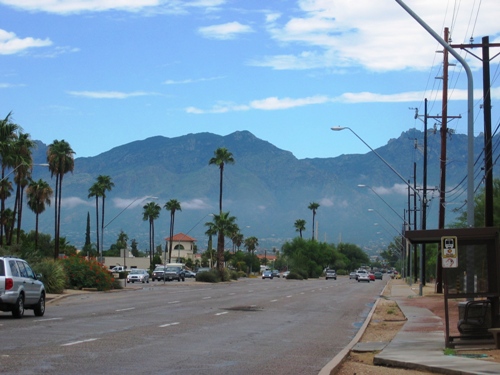For the other three parts of this (one in Musings, two at the Outpost, click below:
Outpost: Intro, Climate
In Musings: The Desert
Outpost: History and Culture
This is going to be a "fast and dirty" entry so that I can go to bed. Tucson is surrounded by four sets of mountains:
North: The Catalinas.
This is where Mount Lemmon is, with Summerhaven at the top. My very first Round Robin Photo Challenges entry was a series on a trip up Mount Lemmon. (Speaking of which, the next Round Robin topic is "Nostalgia." Click the link for details.)
Here is a shot at Molino Basin, about a quarter of the way up Mt. Lemmon Highway. The habitats at different elevations are called "sky islands," because they represent distinct ecosystems that are separate from surrounding areas. You'll find different species of birds among the aspen pines beyond Summerhaven than what you'll see in the trees at Molino.
More on Mount Lemmon:
Diary of a Day Trip, Part One
Diary of a Day Trip: Mount Lemmon, Part Two
Diary of a Day Trip: Mount Lemmon, Part Three
Diary of a Day Trip: Mount Lemmon, Part Four
East: The Rincons

The Rincons are similar to the Catalinas, but shorter and undeveloped (i.e., no roads or houses on them). They are part of Saguaro National Park East. Colossal Cave is at the Rincon end of town.
South: The Santa Ritas.

These are a bit farther away than the others, down below the airport and Davis-Monthan AFB, toward Green Valley and including Madera Canyon. There was a fire in the Santa Ritas in 2005.
West: The Tucson Mountains

The Tucsons are very different from the other three ranges, looking like a bunch of piled rocks more than anything else. (Southern California has many mountains like these.) We used to live in the foothills of the Tucson Mountains. The range separates Tucson from the Avra Valley, where the Arizona Sonora Desert Museum and Old Tucson are, and where Saguaro National Park West is. The most spectacular way from the city to Old Tucson is across Gates Pass, a steep, scary, winding road with a great scenic lookout at the top. The photo is of my dad in Gates Pass in 2005.
Karen
Tucson
 It was full of interesting new birds like
It was full of interesting new birds like 










 You are looking at an archive edition of
You are looking at an archive edition of 


